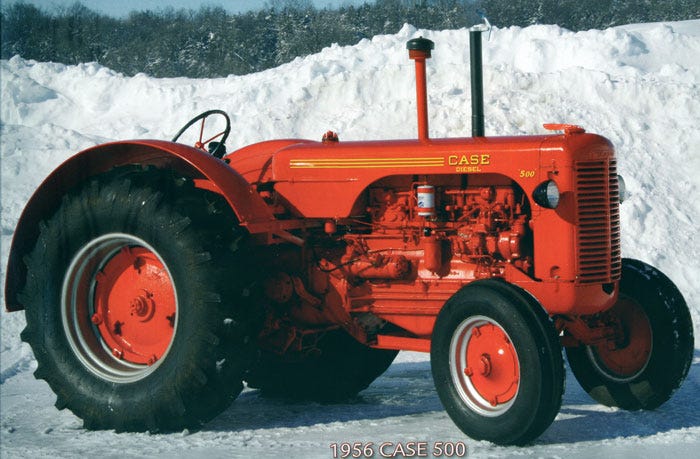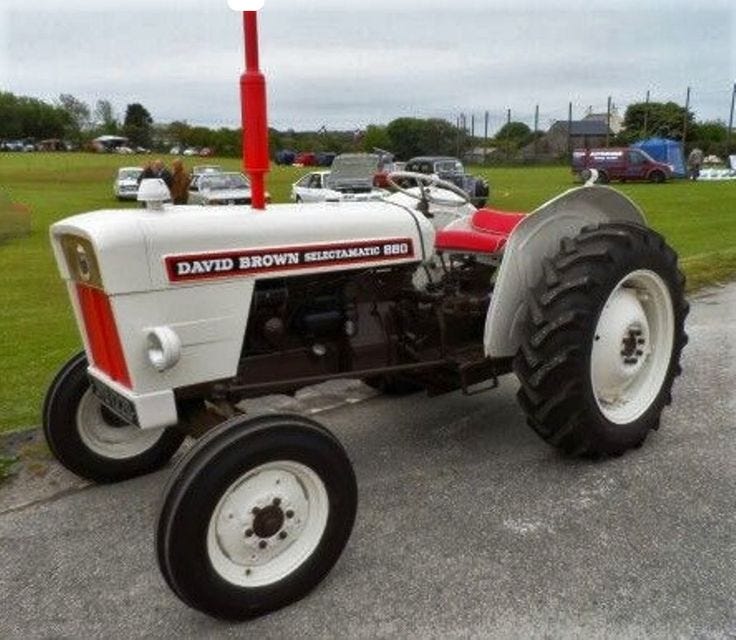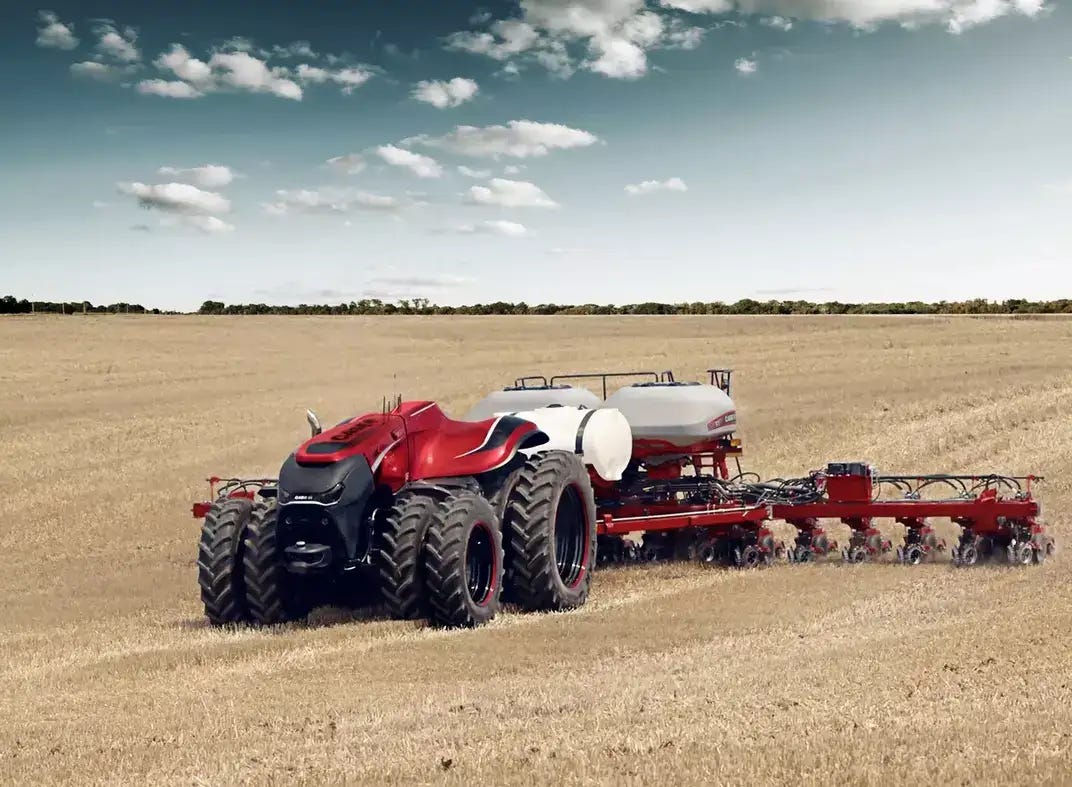In 1939, Case changed its color scheme to Flambeau Red from the former grey color.
With the start of World War II, Case’s tractors were in even greater demand. More than 15,000 of its tractors went to the military between 1941 and 1945. New tractors were designed and manufactured with war-needs in mind. Case was also producing items such as shells, aircraft wings, and gun mounts for the war effort.
Profits declined between 1950 and 1953, in part because of outdated products. The production and sale of threshers was finally discontinued in 1953. Competitors introduced lighter models of tractors in the late 1930s, and these units became popular after the war. Case, on the other hand, had at the end of the war roughly the same heavy series it had at the beginning. Poor engineering hurt Case during the early 1950s as well, as did a propensity to blame the dealer rather than the product. Items such as Case’s hay baler, which had topped the market in 1941, lagged to less than 5 percent of baler sales in 1953 because Case failed to respond to a competitor’s improvements.
All of these problems added up to a crisis in leadership at Case. Clausen consistently made decisions opposed to change: he opposed diesel engines for domestic sales; he believed farmers preferred “dependability” to changes such as a foot-operated clutch, a cab, and an oil filter—all of which a 1946 survey of farmers specified as desired. When Clausen left the presidency in 1948, Theodore Johnson took over. The company continued to drift, with a lackluster response to competition, and no notable innovations. Johnson was replaced in 1953 by John T. Brown.
Under Brown’s direction, Case released a multitude of new or improved implements, including the 500 series tractor, which would become a popular line. The 500 had a six-cylinder, fuel-injected, diesel engine, power steering, and a push-button start. Two manure spreaders were unveiled in 1956. That same year, however, Case reported its second loss since 1953. For the first time, bankruptcy seemed a possibility. Diversification seemed the only remedy.
Case launched its industrial equipment line in 1957 as though it were new, but it had been making industrial units based on agricultural models for three decades. Case applied itself to expanding this sector of its line, and turned to Caterpillar Company for marketing assistance. To revitalize its industrial line, Case acquired American Tractor Corporation (ATC) in 1957. ATC’s volume around purchase time was $10 million, but the company was in debt due to recent rapid growth. Its assets included a vigorous president, Marc Bori Rojtman; a strong line of distributors and dealers; and a sturdy line of crawler tractors and loader backhoes—the company’s star product. Under Rojtman, Case’s manufacturing capacity improved, new retailers were attracted, and the company moved confidently into the construction equipment business.
Rojtman’s showman’s personality led to dazzling regional shows to promote new product lines. Sales rose 50 percent in 1957, reaching $124 million. Income the following year was more than tripled. Clausen, head of the board, strongly opposed Rojtman’s presidency and his debt load, and resigned in 1958. An economic downturn in 1958 left the company in a precarious position. William Grede replaced Rojtman in 1960.
Case’s debt load in 1959 was $236 million. It had become the country’s fourth largest farm and construction equipment producer. Unable to meet a $145 million bill due on short-term notes in 1962, a bank agreement was negotiated which called for reorganization and deferment of most of the interest until 1967, so Case could focus on paying down principal. Reorganization included the ousting of Grede. He was succeeded by Merritt D. Hill, who had previously worked in Ford’s Tractor and Implement Division.
Hill brought talent with him from Detroit, including a chief product engineer. He completely restructured Case. Money constraints impeded the development of new product lines, but Case managed to stay in the ring with competitors such as Ford and Deere, as the new head of its engineering department insisted. In 1964, Case introduced the 1200 Traction King, a 4-wheel drive, 120 horsepower giant that marked the company’s entry into the large agricultural tractor market.
In May 1964, the Kern County Land Company (KCL) of California acquired majority stock in Case. KCL was founded in 1874 and began as a cattle-raising venture that branched into petroleum royalties after oil was discovered. KCL was cash-rich and agreed not to dictate Case’s growth or internal decisions. These circumstances allowed Case to expand between 1964 and 1967, in accordance with a booming demand for existing products and the itch to produce new ones. By 1966, Case’s income decline had been reversed. Hill became chairman of the board and Charles A. Anderson became president.
Suddenly KCL, under threat of a hostile takeover by Armand Hammer, wooed a friendly buyer instead, and ended up being acquired by Tenneco Company of Houston. In 1968, Tenneco acquired Drott Manufacturing Company in Wisconsin and leased it to Case. Case had been buying loader buckets from Drott for years. Case essentially exited the farm implement business by 1970. And though Case dropped its combine business in 1972, an acquisition in 1985 returned harvesting equipment to Case’s line.
In 1972, Case bought David Brown, Ltd., a British agricultural equipment firm founded in 1860. Brown had a large distribution system in Britain and Case concentrated its small tractor production in Brown. Thomas Guendel took over company presidency in 1972 and commanded a chapter of unprecedented growth until he left Case seven years later. Sales quadrupled during that time and earnings improved more than 600 percent. The phenomenal growth was due largely to increased success in construction equipment and overseas markets.
Case started the 1980s with 28,000 employees, but it did not anticipate the recession that would shatter the farming community. New general purpose tractors had been introduced in 1983 and were languishing. Four more 94 series tractors were unveiled in 1984, but by that point, farms were in a real crisis. Case cut production to 55 percent of capacity and it still exceeded demand. In 1983, Case lost $68 million, and followed that with a deficit of $105 million in 1984.
In 1984, Tenneco bought International Harvester's agricultural equipment division and merged it into Case, and the farm equipment brands were combined as Case IH, although the corporation legally remained the J. I. Case Company. It continued as such until 1994, when Tenneco divested it as the Case Equipment Corporation. Case Equipment became Case Corporation and later Case LLC.
When Case IH bought out Steiger in 1986 they also continued the Steiger branding.
In 1999, Case LLC merged with New Holland Agriculture to form CNH Global, a Fiat Group division, which has since been demerged into a corporation that is majority-owned by Fiat Industrial. The name Case lives on in two CNH brands: Case CE (from "Construction Equipment"), which is the world's third largest brand of construction equipment, and Case IH, which is the world's second largest brand of agricultural equipment.
Sources:
J.I. Case Company. encylopedia.com website
Who was J.I. Case?, Robert N. Pripps, Farm Collector magazine
caseih.com website
cnh.com website










